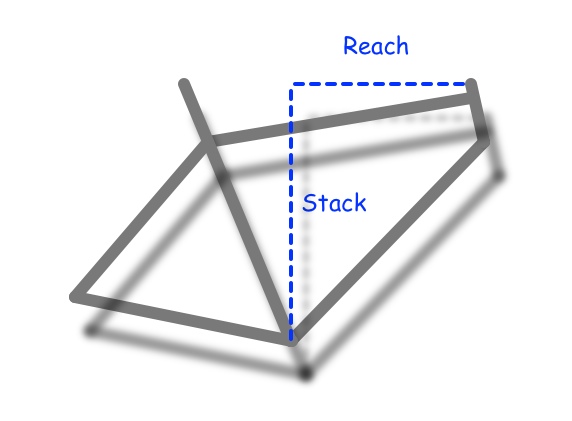Fit and frame
We’ve seen that, given a suitable crank length, fit is a combination of saddle height, setback and reach. Though some adjustment is possible by moving the saddle up and down in the frame and fore and aft on the seatpin, and by changing the stem, it is constrained by the size and geometry of the frame. Despite being the quoted 'frame size' the seat tube length is actually relatively unimportant as the saddle can be raised and lowered far more than it can be moved fore and aft. Far more fundamental are top tube length and the frame angle.
Angle
The angle that matters is the one that the seat tube makes with the horizontal
as this determines where the centre of gravity and the knees are relative
to the pedals.
For most of the population the thigh to lower leg length ratio is such that
a seat angle of about 73 or 74 degrees will provide an orthodox, equilibrium
position.
Tube Lengths
Frame size is always the seat tube length, though some manufacturers quote centre-to-centre and others centre to top. Though frame size has relatively little influence on saddle height it does determine the range of height difference possible between saddle and handlebars. Like for like, a smaller frame is typically stiffer, will normally have a have a shorter top tube and, for reasons that we'll move onto, will probably have a steeper frame angle.
The top tube length is very important. While the saddle height is quickly and easily adjusted the reach can only be adjusted by swapping the stem (i.e. buying a different one). Stems come in a range of sizes from 4cm to 15cm - but a stem that's disproportionately long or short for the frame can adversely affect the way the bike handles.
“Size, angle, toptube”
A frame can be specified to fit in terms of size, angle and toptube. These three match up with saddle height, setback and reach. A good frame builder will know how to build the rest of the frame to retain the correct balance and performance.
Compact Frames
Since I originally wrote this there has been an almost universal shift from horzontal to sloping top tubes. For fitting and measurement purposes 'top tube' length always still refers to the horizontal equivalent and 'size', when given as a number of centimetres, to the 'horizontal equivalent' size. In some cases compact frames are simply sold as Small, Medium, Large.
Stack and Reach
A very positive improvement in frame geometry specification (again since I originally wrote this item) has been the adoption of 'Stack and Reach'. Unfortunately 'reach' in this context is different from the traditional use of the term (as I've used it so far). As you can see from the diagram below, stack and reach are the co-ordinates of the top of the head tube. Describing frames using angle, stack and reach makes a lot of sense as compact frames can be precisely measured and compared.

'Sportif' Frames
Traditional off-the-peg sports frames derive from racing bikes. Most bike racers start cycling young and develop the strength and flexibility to ride comfortably in a low, aerodynamic position. Cyclists less concerned about speed, traditionally described as 'cycle tourists', typically bought bikes with shorter top tubes and longer head tubes to give themselves a more upright position. However, touring bikes are normally heavy and distinctly un-sexy! With the increasing popularity of sportif (or sportive) rides, and large numbers of adults taking up cycling, bike manufacturers now meet the needs of people who do not have the flexibility to be comfortable on a bike with racing geometry, but who still want a lightweight, high-performance bike, with 'Sportive bikes'.
Sportive frames have short top tubes and long head tubes (short reach, high stack)


